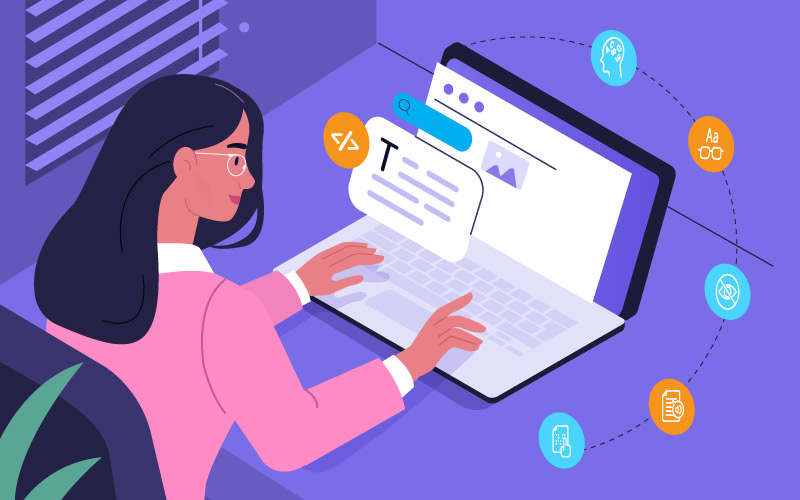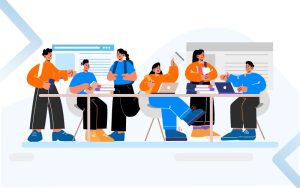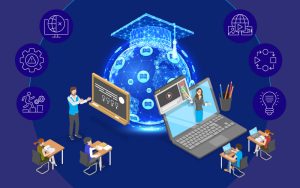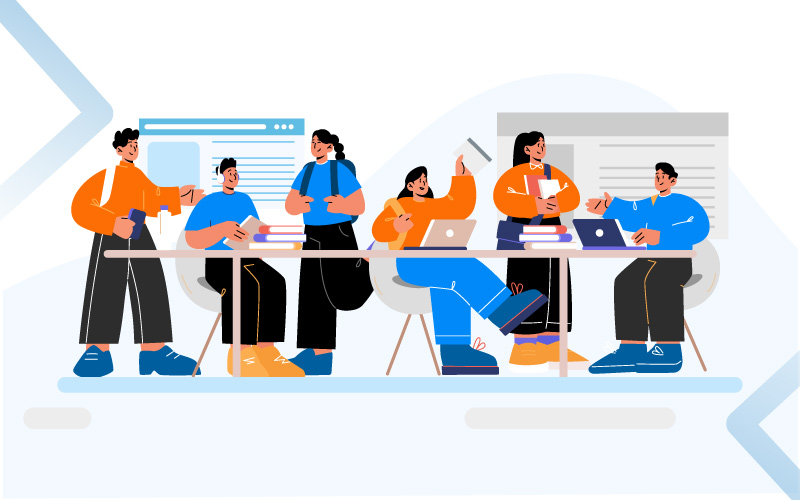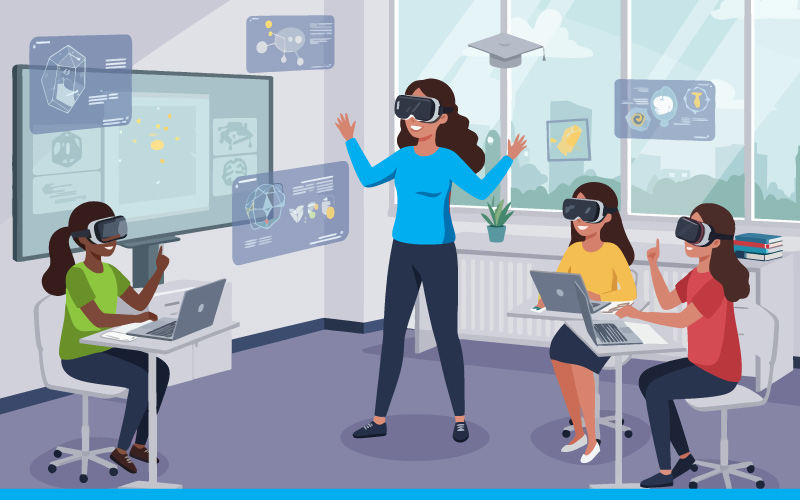In today’s digitally-driven classrooms, accessible eLearning design means creating content from day one that meets WCAG standards and serves every learner. WCAG-by-default incorporates accessibility into the authoring process rather than retrofitting things after the fact. This is achieved by the use of keyboard-friendly navigation, high contrast colors, alt-text for pictures, subtitles for media, semantic markup, and logical headings.
This strategy is in line with global frameworks such as Universal Design for Learning (UDL), which seeks to eliminate obstacles in the classroom so that “all learners can access and participate in meaningful, challenging learning opportunities.“. UNESCO highlights the need for technology to benefit individuals and encourage inclusion for underrepresented groups, specifically mentioning that digital innovation should help people with impairments.
In practice, leading standards (W3C’s ATAG) call on authoring tools and platforms to “enable, support, and promote the production of content” that conforms to WCAG. In short, by making accessibility “everyone’s responsibility”, schools can improve equity and outcomes for all students while laying the foundation for truly inclusive pedagogy.
Why “WCAG-by-Default” Matters
There are several advantages to creating new content with accessibility in mind from the start:
- Inclusive Pedagogy & Equity: A fundamental component of inclusive teaching methods and Universal Design for Learning (UDL) is accessible design. Teachers can accommodate different learning demands by offering a variety of representation and interaction methods (such as text and speech, visuals and audio, and consistent layouts). Research shows that when platforms include robust accessibility features, students with disabilities engage more and complete courses at higher rates. For example, one study found that making content accessible can raise retention and course completion by 10–15% for learners with disabilities. Accessible eLearning also benefits other groups (English-language learners, students with temporary injuries, neurodiverse learners, etc.), helping all students thrive and narrowing achievement gaps.
- Legal Compliance & Risk Mitigation: An accessibility-by-design policy preempts complaints, lawsuits, and audits. In the US, Title II of the ADA now explicitly requires public schools and universities to meet WCAG 2.1 AA for web and app content. The DOJ’s 2024 rule underscores that states and districts must proactively fix accessibility barriers – “without placing the burden… on people with disabilities” to request accommodations. Similarly, UK law mandates that public education sites meet WCAG 2.2 AA, and Australia’s Disability Discrimination Act (enforced by the Human Rights Commission) requires digital products to adhere to WCAG 2.1 AA. In Europe, the 2025 European Accessibility Act will force all eLearning products and services to earn a CE mark by proving WCAG conformance. Failure to comply can be costly: each accessibility lawsuit or OCR (Office for Civil Rights) complaint can cost tens or hundreds of thousands of dollars. By contrast, designing for accessibility upfront saves 20–50% in remediation costs compared to fixing issues later, and it demonstrates goodwill that can deter enforcement actions.
- Strategic Goals (Inclusion & Performance): Accessible eLearning aligns with each district’s mission and equity goals. It supports SDG4 (inclusive education) and national strategies (EU’s Digital Education Plan aims for “inclusive and accessible digital education”). Districts that brand themselves as champions of inclusion also attract grants and community support. Studies indicate that technology investments achieve better ROI when they advance accessibility: schools using accessibility analytics see higher overall EdTech usage and engagement. In sum, WCAG-by-default strengthens inclusive pedagogy – enabling teachers to deliver differentiated instruction and students to self-advocate – and it underpins equity of outcomes so no student is left behind.
Global Policy Landscape for K–12 Accessibility
Across the world, governments and standards bodies are codifying WCAG as the benchmark for educational technology:
- United States (Title II ADA / Section 504) – All public K–12 schools and districts (as “public entities”) fall under ADA Title II. The 2024 DOJ rule makes WCAG 2.1 AA the technical standard for state/local government websites and apps. The rule explicitly cites “web content and mobile apps” used by schools, meaning every LMS, portal, and digital textbook must comply. The Office for Civil Rights (OCR) has also signaled heightened enforcement: recent guidance and settlements stress that inaccessible curricula violate Section 504. Notably, the DOJ now rejects the old “undue burden” defense – districts must proactively audit and fix content, rather than wait for a complaint. A new rule will affect roughly 7.5 million U.S. students with disabilities, so institutions should plan accordingly.
- United Kingdom – The Public Sector Bodies (Websites and Apps) Accessibility Regulations require WCAG 2.2 AA for all public sector digital services. Many UK schools (especially larger academies and free schools) adhere to these standards. The Government Digital Service provides a “one-star to three-star” accessibility rating system, but at minimum they must meet WCAG 2.2 AA or risk enforcement by Ofsted or local authorities. In keeping with scholarly research showing that accessible content improves comprehension for all learners, the Cabinet Office and DfE advocate for the use of Clear Language and UDL-style techniques in online resources.
- European Union – The 2019 European Accessibility Act (EAA) requires member states to enact national laws by 2025. It mandates that education platforms (especially any sold or freely available as products/services) meet harmonized accessibility standards. For example, e-learning software released after June 28, 2025 will need CE certification, which hinges on WCAG/EN 301 549 compliance. The EU’s Digital Education Action Plan explicitly aims for “high-quality, inclusive and accessible digital education”. Several EU countries have already transposed similar rules: for instance, France’s Référentiel AccessiWeb and Germany’s BITV2 require public education sites to be WCAG 2.1 AA compliant, and penalties can include fines or project shutdowns.
- Australia and APAC – Under Australia’s Disability Discrimination Act, the Human Rights Commission recommends WCAG 2.1 AA as the benchmark. The government’s Digital Transformation Agency runs training for accessible service design, and the ICT Procurement Standard (modeled on Section 508/EN 301 549) requires any technology bought by government agencies (including education) to be accessible. New South Wales and Queensland education departments mandate accessibility in digital learning resources. In Singapore and New Zealand, accessibility policies for schools refer to WCAG as a best practice. Across APAC, UNESCO’s Regional Center for Education in the Pacific promotes the use of inclusive tech and UDL to meet Sustainable Development Goals – highlighting that accessible digital learning is key to equity.
- Other Regions (MENA, Latin America) – The UNESCO Education 2030 framework and national disability laws in many countries are pushing for accessible curricula. For example, Israel’s Ministry of Education requires all digital content to be perceivable by screen readers and hearing aids. In the Middle East, Bahrain and Qatar have incorporated WCAG into e-learning standards for schools. While legal enforcement varies, international organizations stress that accessible EdTech is part of a 21st-century education system for all.
Operationalizing Accessibility in K-12
Transitioning to accessible-by-design requires a district-wide strategy. School leaders and vendors should consider these operational steps:
- Governance & Policy: Create a clear policy for digital accessibility that makes WCAG compliance a must. Incorporate explicit language pledging to use accessible design within service contracts or Board rules. For example, VPAT (Voluntary Product Accessibility Template) documentation and WCAG AA compliancecosn.org should be required in RFPs for new products. Accessibility standards in tech procurement are currently permitted in Kansas and California, and other governments (like Minnesota) use RFP score rubrics based on WCAG. Having clear policies guarantees that accessibility is incorporated into every project and is not an alternative.
- Inclusive Procurement: Train procurement officers to evaluate accessibility before purchase. Use frameworks like the global EN 301 549 (which references WCAG 2.1 AA) or Australia’s ICT Standard as checklists. Include third-party audits for LMS vendors and e-textbook publishers. CoSN recommends inserting WCAG criteria into contracts and purchase orders. This prevents scenarios where an inaccessible platform is later rejected or requires expensive remediation. When evaluating authoring tools (e.g., Rise, Captivate), prefer those supporting ATAG principles (i.e. tools that themselves are accessible and produce accessible output).
- Cross-Department Training: Build capacity among teachers, instructional designers, IT staff, and special education teams. Professional learning should cover key WCAG concepts (alt text, captions, semantic structure) and Universal Design practices. Leverage resources like the Center on Inclusive Technology & Education Systems (CITES) and CAST’s AEM Center for webinars and guides. As CoSN notes, “building staff capacity to provide accessible learning experiences… creates shared expectations”. For example, Baltimore County Public Schools instituted joint planning time for general and special educators to co-design lessons, embedding accessibility from the outset. Including students with disabilities in user testing can also help refine materials.
- Content Creation Workflows: Integrate accessibility checks at every content stage. Start with design templates that enforce contrast and readable fonts. Require alt-text when uploading images or graphs, captions on all videos, and transcripts for audio clips. Use the WCAG POUR framework (Perceivable, Operable, Understandable, Robust) as a checklist during development. Provide creators with tools (like content checkers or accessibility assistants) in their authoring environment. For example, read-aloud and dyslexia-friendly fonts can be enabled by default. Encourage the use of semantic headings (H1, H2, …) in LMS pages and documents so that screen readers can parse structure easily.
- Ongoing Audits & Feedback Loops: Make accessibility reviews routine. Establish a schedule for automated scans (using tools like WAVE or Axe) and periodic manual audits (including screen-reader walkthroughs). Publish an accessibility statement and a feedback form so students, parents, or staff can report barriers. A feedback channel helps catch issues early (for instance, if a teacher notices a quiz isn’t keyboard-navigable, they can flag it). Districts may consider hiring an accessibility coordinator or consultant to oversee audits and track remediation. (For example, one Midwest consortium found that without auditing, older PowerPoint and PDF files remained inaccessible by default.)
Accessibility in Authoring Tools and Platforms
The tools used to create eLearning can greatly simplify or complicate compliance:
- WCAG-Conscious Authoring: Select authoring platforms known for accessibility. Many modern LMS and course-builder tools include built-in checks or guidance (e.g. Adobe Captivate, Articulate Rise, H5P). Follow W3C’s Authoring Tool Accessibility Guidelines (ATAG). ATAG recommends that an authoring tool “help authors create more accessible web content” by automatically marking up elements or warning of issues. For instance, a good tool will prompt the creator if an image has no alt text, or will offer caption tracks for embedded video.
- Validation and AI Assistance: Leverage technology to catch issues. Automated checkers can flag missing form labels or low contrast. Emerging AI-based solutions (like caption generators or color-contrast enhancers) can accelerate remediation. Note: AI can assist but cannot replace human oversight; always verify auto-generated captions or descriptions for accuracy. Using these tools early (e.g. during review) is far cheaper than fixing content after release.
- Future-Proofing: Keep an eye on evolving standards. Many current accessibility guidelines were written with older web tech in mind; new versions (WCAG 3) and assistive innovations are coming. Build content with open web standards (semantic HTML, ARIA roles) so that future technologies (like voice assistants or VR interfaces) can still interpret it. As CoSN advises, districts should commit to “ongoing professional learning” on accessibility.
Case Studies & International Examples
- European Digital Textbooks: In 2023, several EU member education ministries began certifying digital textbooks under the EAA rules. For example, a Spanish regional education board now requires any new ebook to include synchronized text-audio modes – a direct carryover of EAA Annex I requirements (see ReadSpeaker’s analysis). These regions report improved literacy outcomes for students with print disabilities once multi-modal textbooks were deployed.
- China’s Smart Education Platform: In Asia, China’s national “Smart Education of China” platform has been recognized by UNESCO for promoting continuity and equity in learning. By delivering high-quality resources to remote and underserved schools (with built-in screen-reader and subtitle features), it helped narrow the rural-urban achievement gap. Chinese officials credit accessible design for “facilitating access to high-quality educational resources for students across the economy”.
- U.S. School District Initiatives: Some U.S. states have passed laws requiring accessible digital content in schools. Illinois’ HB 26 (2021) mandates that digital learning materials meet WCAG AA, including captions on all videos. Similarly, Washington and Minnesota have procured accessible tech statewide (citing ANSI/ISO standards aligned with WCAG). Districts are also partnering with non-profits: for example, New York City schools worked with CAST to create an accessibility toolkit and train 200 educators, resulting in a 40% drop in accommodation requests within a year.
- UNESCO & Global Education: UNESCO’s Education 2030 agenda stresses that digital learning should advance inclusion. Its reports cite cases from Mexico to Kenya where accessible eLearning (especially during COVID-19) ensured that children with disabilities continued learning when physical schools closed. UNESCO also supports the Qingdao Declaration which calls for building “inclusive and responsive education systems” – a goal directly served by WCAG-compliant content.
Embedding Accessibility for Outcomes
By designing with accessibility in mind, K–12 leaders achieve multiple strategic aims:
- Improved Student Performance: While research on direct causation is still growing, early evidence is promising. Districts report fewer course withdrawals and higher assessment scores among students when materials are accessible (mirroring trends in higher ed). For example, one survey found that accessible educational videos (with captions and audio descriptions) increased comprehension scores by over 25% for learners with visual or hearing impairments. Even students without disabilities benefit from better structure and clarity.
- Equitable Learning Experiences: Students from all backgrounds gain a fair chance at success. If students with disabilities can interact fully with a science simulation or reading platform, their performance gap with peers can shrink. In the aggregate, this promotes schoolwide equity metrics. Leaders can link accessible design to social-emotional goals as well – when students see that “the system” accommodates their needs, they feel more included and motivated.
- Community and Market Engagement: Accessibility commitments signal values. Parents of students with disabilities and disability advocacy groups watch for districts’ efforts. Schools that champion inclusive tech may attract more diverse enrollment and community support. Notably, the population of children with disabilities is growing; in the U.S., about 14% of K–12 students receive special education services. Ignoring their needs means excluding a significant constituency (and, as one business analysis noted, potentially sacrificing billions in community economic contribution).
Related Resources
For a step-by-step roadmap to implementing WCAG in your district, see our Ultimate K-12 WCAG Implementation Roadmap. For guidance on auditing existing courses and content, check out our Step-by-Step WCAG Audits for Existing eLearning Content guide. These resources (along with training workshops and checklists) provide granular best practices for K–12 leaders, edtech vendors, and content creators committed to an accessible-by-default approach.
Overall, designing new content with WCAG by default is not only an ethical and legal imperative, it’s a practical strategy for inclusive excellence. By updating procurement policies, training staff, and using WCAG-savvy authoring tools, schools in the US, UK, Europe, and beyond can transform digital learning. The result is a more equitable school system where every student, regardless of ability, has full access to the highest quality of learning they need.
Sources: Government regulations, international guidelines, and recent studies have been cited in this article. You can refer to them below:
- The US DOJ Title II rule (requiring WCAG 2.1 AA) ada.govamericanprogress.org;
- UK Government accessibility laws gov.uk;
- The European Accessibility Act’s eLearning rules readspeaker.comreadspeaker.com;
- Australia’s Disability Discrimination Act guidance aeldata.com;
- UNESCO and OECD reports on digital inclusion unesco.org ; education.ec.europa.eu;
- K–12 technology policy recommendations (CoSN, CAST) cosn.org ; cast.org;
- Analyses of the educational and financial impacts of accessibility americanprogress.org ; thenextweb.com.


